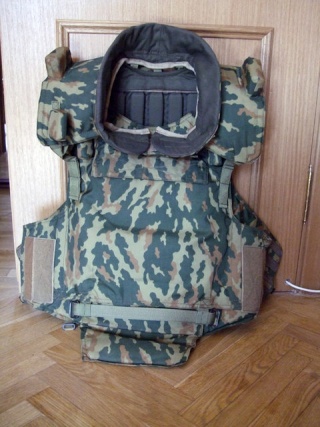Anyway, I just want to know what Russia currently uses, and is planning to use.
I know that the helmet is the 6b26. But what about armor?
 Body Armour and Protection systems
Body Armour and Protection systems

sepheronx wrote:Did not notice that I misspelled standard (Vladimir, if you do not mind, may you please make the fix?)
do you have any experience with these body armor? What are they like?
Vladimir79 wrote:sepheronx wrote:Did not notice that I misspelled standard (Vladimir, if you do not mind, may you please make the fix?)
do you have any experience with these body armor? What are they like?
Fawkn heavy... as a paratrooper, they were hell on my back during landings. We often waited to collect our gear before we put them on. They are also uncomfortable and make you sweat. We need to get Dragon Skin.

 Re: Body Armour and Protection systems
Re: Body Armour and Protection systems
 Re: Body Armour and Protection systems
Re: Body Armour and Protection systems Re: Body Armour and Protection systems
Re: Body Armour and Protection systems Re: Body Armour and Protection systems
Re: Body Armour and Protection systems Re: Body Armour and Protection systems
Re: Body Armour and Protection systemsa level of VI is equivalent to the NIJ's standard of IV, which means Sniper rifle resistant (although, anything 12.7 mm or bigger is getting through regardless).
Also, their Night optics are finally close to parity. I'm not sure what Generation our Optics are, but with Gen 3 optics, they're getting damn close.
 Re: Body Armour and Protection systems
Re: Body Armour and Protection systemsAustin wrote:Makes a nice read
RUSSIAN INFANTRY COMBAT SYSTEM DEVELOPMENT PROGRAMS
 Re: Body Armour and Protection systems
Re: Body Armour and Protection systems Re: Body Armour and Protection systems
Re: Body Armour and Protection systems Re: Body Armour and Protection systems
Re: Body Armour and Protection systems
 Re: Body Armour and Protection systems
Re: Body Armour and Protection systemsThe Russian naval infantry will soon be equipped with floating bulletproof life vests, the naval infantry commander said.
The vest, specifically designed for maritime applications, offers full ballistic protection against light weapon threats while providing floating capabilities.
"This vest has been designed for naval infantry as well as for seamen serving on combat ships," Maj. Gen. Alexander Kolpachenko told the Echo Moskvy radio on Saturday.
The general said that despite its heavy weight the vest was perfectly floatable and could easily support the wearer, his weapons and ammunition in water.
"It [the vest] surpasses all types of body armor worn by servicemen in the Ground Forces," Kolpachenko said, adding that the delivery of the new floating bulletproof life vest to naval infantry units would start in 2011.
 Re: Body Armour and Protection systems
Re: Body Armour and Protection systemsGarryB wrote:a level of VI is equivalent to the NIJ's standard of IV, which means Sniper rifle resistant (although, anything 12.7 mm or bigger is getting through regardless).
Might stop their silenced 12.7mm sniper weapons at ranges of 400m or so.
ie:
http://world.guns.ru/sniper/sn72-e.htm
Also, their Night optics are finally close to parity. I'm not sure what Generation our Optics are, but with Gen 3 optics, they're getting damn close.
They are working on gen IV which reduces blooming and is more tolerant of bright lights in the field of view.
 Re: Body Armour and Protection systems
Re: Body Armour and Protection systemsAny idea when they're going to start incorporating QWIPs into their systems? We have QWIPs in our FLIRs now apparently :O
Well, lets admit it, not a lot of foreign nations use subsonic 12.7 mm rounds anyways
 Re: Body Armour and Protection systems
Re: Body Armour and Protection systemsAny idea when they're going to start incorporating QWIPs into their systems? We have QWIPs in our FLIRs now apparently :O
I doubt they will send me a memo when they do. Your people didn't send me a memo either.
Well, lets admit it, not a lot of foreign nations use subsonic 12.7 mm rounds anyways
The people who use such sneaky beaky stuff rarely talk about what sort of ammo types they prefer and there are plenty of those sorts of people in many western and eastern countries.
The point is that as vests become more widely used then people with the job of shooting people will more and more have to resort to this sort of ammo and ammo like it or more powerful.
There certainly seem to be two camps on the issue... small calibre high velocity and larger calibre heavier bullet weight and both have their good and bad points. The first team ended with flechettes but accuracy could not be guaranteed because of the way the sabot seperated in small calibre weapons but with velocities of 1.4km/s out to 800m or so you had no problems with aiming because bullet drop was so small no elevation adjustment was required so the rifles had fixed iron sights like pistols.
Penetration of flak jackets wasn't a problem either, but lethality was. It was found that a flechette could go through a human heart and it might not stop beating... it would just make a very small hole. Proponents in the other direction seem to be winning however because 5.45mm, 7.62 x 39mm, and 5.56mm ammo has all gotten heavier over time with initial bullet weights of 52 grain, 122 grain, and 55 grain, changing over time to 60 grain, 155 grain (193 grain for subsonic), and 62 grain projectiles.
The 9x39mm rounds with 250 grain projectiles also became popular in the AS and VSS subsonic weapons


 Re: Body Armour and Protection systems
Re: Body Armour and Protection systemsThe only real advantage I see from subsonic rounds are the reduced noise it provides, even without suppressors. But in any case, a NIJ class IV or GOST class VI vest should be able to stop a subsonic 12.7 mm no problem so I think Russia has it fine.
 Re: Body Armour and Protection systems
Re: Body Armour and Protection systems Re: Body Armour and Protection systems
Re: Body Armour and Protection systems